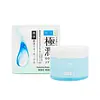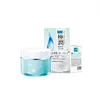What's inside
What's inside
 Key Ingredients
Key Ingredients

 Benefits
Benefits

 Concerns
Concerns

 Ingredients Side-by-side
Ingredients Side-by-side

Water
Skin ConditioningAlcohol
AntimicrobialGlycerin
HumectantNiacinamide
SmoothingButylene Glycol
HumectantDimethicone
Emollient1,2-Hexanediol
Skin ConditioningIsononyl Isononanoate
EmollientAcrylates/C10-30 Alkyl Acrylate Crosspolymer
Emulsion StabilisingPhenoxyethanol
PreservativeTromethamine
BufferingEthylhexylglycerin
Skin ConditioningDimethiconol
EmollientBetaine
HumectantXanthan Gum
EmulsifyingAdenosine
Skin ConditioningHydrogenated Lecithin
EmulsifyingTocopheryl Acetate
AntioxidantSodium Hyaluronate
HumectantPiper Methysticum Leaf/Root/Stem Extract
Skin ConditioningPhellinus Linteus Extract
Skin ConditioningHydrolyzed Hyaluronic Acid
HumectantArctium Lappa Root Extract
Skin ConditioningCitrus Medica Peel Oil
Soluble Collagen
HumectantPortulaca Oleracea Extract
Skin ConditioningPanthenol
Skin ConditioningCitrus Grandis Peel Oil
MaskingCitrus Aurantium Bergamia Fruit Oil
MaskingCitrus Aurantium Dulcis Peel Oil
MaskingPueraria Thunbergiana Root Extract
Skin ConditioningPaeonia Lactiflora Root Extract
Skin ConditioningGlycyrrhiza Glabra Root Extract
BleachingCnidium Officinale Root Extract
Skin ConditioningAloe Barbadensis Leaf Juice
Skin ConditioningHydrogenated Phosphatidylcholine
EmulsifyingRaffinose
Skin ConditioningIsostearyl Isostearate
EmollientPelargonium Graveolens Flower Oil
MaskingCholesterol
EmollientCeramide NP
Skin ConditioningFolic Acid
Skin ConditioningTocopheryl Linoleate
AntioxidantSodium Acetylated Hyaluronate
HumectantPotassium Cetyl Phosphate
EmulsifyingInulin Lauryl Carbamate
Emulsion StabilisingCedrus Atlantica Bark Oil
MaskingCananga Odorata Flower Oil
MaskingIllicium Verum Fruit/Seed Oil
MaskingCymbopogon Nardus Oil
MaskingEugenia Caryophyllus Leaf Oil
MaskingCI 42090
Cosmetic ColorantAnthemis Nobilis Flower Oil
MaskingJasminum Officinale Oil
MaskingSantalum Album Oil
MaskingFerula Galbaniflua Resin Oil
AntimicrobialRose Flower Oil
MaskingPalmitoyl Pentapeptide-4
Skin ConditioningWater, Alcohol, Glycerin, Niacinamide, Butylene Glycol, Dimethicone, 1,2-Hexanediol, Isononyl Isononanoate, Acrylates/C10-30 Alkyl Acrylate Crosspolymer, Phenoxyethanol, Tromethamine, Ethylhexylglycerin, Dimethiconol, Betaine, Xanthan Gum, Adenosine, Hydrogenated Lecithin, Tocopheryl Acetate, Sodium Hyaluronate, Piper Methysticum Leaf/Root/Stem Extract, Phellinus Linteus Extract, Hydrolyzed Hyaluronic Acid, Arctium Lappa Root Extract, Citrus Medica Peel Oil, Soluble Collagen, Portulaca Oleracea Extract, Panthenol, Citrus Grandis Peel Oil, Citrus Aurantium Bergamia Fruit Oil, Citrus Aurantium Dulcis Peel Oil, Pueraria Thunbergiana Root Extract, Paeonia Lactiflora Root Extract, Glycyrrhiza Glabra Root Extract, Cnidium Officinale Root Extract, Aloe Barbadensis Leaf Juice, Hydrogenated Phosphatidylcholine, Raffinose, Isostearyl Isostearate, Pelargonium Graveolens Flower Oil, Cholesterol, Ceramide NP, Folic Acid, Tocopheryl Linoleate, Sodium Acetylated Hyaluronate, Potassium Cetyl Phosphate, Inulin Lauryl Carbamate, Cedrus Atlantica Bark Oil, Cananga Odorata Flower Oil, Illicium Verum Fruit/Seed Oil, Cymbopogon Nardus Oil, Eugenia Caryophyllus Leaf Oil, CI 42090, Anthemis Nobilis Flower Oil, Jasminum Officinale Oil, Santalum Album Oil, Ferula Galbaniflua Resin Oil, Rose Flower Oil, Palmitoyl Pentapeptide-4
Water
Skin ConditioningGlycerin
HumectantPropanediol
SolventPentylene Glycol
Skin Conditioning1,2-Hexanediol
Skin ConditioningIsononyl Isononanoate
EmollientSodium Acrylates Crosspolymer-2
AbsorbentPhenoxyethanol
PreservativeCetearyl Alcohol
EmollientTrehalose
HumectantUrea
BufferingEthylhexylglycerin
Skin ConditioningStyrene/Vp Copolymer
Hydrogenated Phosphatidylcholine
EmulsifyingSerine
MaskingCitrus Sinensis Peel Extract
PerfumingCitric Acid
BufferingCarnosine
Skin ConditioningBifida Ferment Lysate
Skin ConditioningGlyceryl Polyacrylate
Algin
MaskingCaprylyl Glycol
EmollientSodium Hyaluronate
HumectantPullulan
Disodium Phosphate
BufferingCitrus Limon Peel Oil
MaskingPelargonium Graveolens Flower Oil
MaskingElettaria Cardamomum Seed Oil
MaskingCitrus Aurantium Bergamia Fruit Oil
MaskingLeontopodium Alpinum Extract
Skin ConditioningSodium Acetylated Hyaluronate
HumectantHydrolyzed Sodium Hyaluronate
Skin ConditioningButylene Glycol
HumectantCananga Odorata Flower Oil
MaskingPolianthes Tuberosa Extract
MaskingPotassium Phosphate
BufferingCollagen
MoisturisingSorbic Acid
PreservativePalmitoyl Tripeptide-5
Skin ConditioningSodium Benzoate
MaskingPotassium Sorbate
PreservativeCeteareth-20
CleansingCaprylic/Capric Triglyceride
MaskingPolyglyceryl-10 Stearate
Skin ConditioningCeramide NP
Skin ConditioningPolysorbate 20
EmulsifyingSodium Hyaluronate Crosspolymer
HumectantMaltodextrin
AbsorbentPalmitoyl Hexapeptide-12
Skin ConditioningSyringa Vulgaris Extract
Skin ConditioningWater, Glycerin, Propanediol, Pentylene Glycol, 1,2-Hexanediol, Isononyl Isononanoate, Sodium Acrylates Crosspolymer-2, Phenoxyethanol, Cetearyl Alcohol, Trehalose, Urea, Ethylhexylglycerin, Styrene/Vp Copolymer, Hydrogenated Phosphatidylcholine, Serine, Citrus Sinensis Peel Extract, Citric Acid, Carnosine, Bifida Ferment Lysate, Glyceryl Polyacrylate, Algin, Caprylyl Glycol, Sodium Hyaluronate, Pullulan, Disodium Phosphate, Citrus Limon Peel Oil, Pelargonium Graveolens Flower Oil, Elettaria Cardamomum Seed Oil, Citrus Aurantium Bergamia Fruit Oil, Leontopodium Alpinum Extract, Sodium Acetylated Hyaluronate, Hydrolyzed Sodium Hyaluronate, Butylene Glycol, Cananga Odorata Flower Oil, Polianthes Tuberosa Extract, Potassium Phosphate, Collagen, Sorbic Acid, Palmitoyl Tripeptide-5, Sodium Benzoate, Potassium Sorbate, Ceteareth-20, Caprylic/Capric Triglyceride, Polyglyceryl-10 Stearate, Ceramide NP, Polysorbate 20, Sodium Hyaluronate Crosspolymer, Maltodextrin, Palmitoyl Hexapeptide-12, Syringa Vulgaris Extract
 Reviews
Reviews

Ingredients Explained
These ingredients are found in both products.
Ingredients higher up in an ingredient list are typically present in a larger amount.
1,2-Hexanediol is a synthetic liquid and another multi-functional powerhouse.
It is a:
- Humectant, drawing moisture into the skin
- Emollient, helping to soften skin
- Solvent, dispersing and stabilizing formulas
- Preservative booster, enhancing the antimicrobial activity of other preservatives
Butylene Glycol (or BG) is used within cosmetic products for a few different reasons:
Overall, Butylene Glycol is a safe and well-rounded ingredient that works well with other ingredients.
Though this ingredient works well with most skin types, some people with sensitive skin may experience a reaction such as allergic rashes, closed comedones, or itchiness.
Learn more about Butylene GlycolCananga Odorata Flower Oil comes from the ylang-ylang flower, Cananga odorata.
Ylang-ylang oil has slight antibacterial, antioxidant and antifungal properties. However, it also contains a number of sensitizing ingredients such as geraniol, limonene, linalool and benzyl benzoate. These compounds are known EU allergens.
The composition of this ingredient depends on the source. Luxury perfumes tend to use higher grade ylang-ylang for their fragrance. Lower grade ylang-ylang is less fragrant.
Learn more about Cananga Odorata Flower OilCeramide NP is a type of ceramide and formally known as ceramide 3.
Ceramides are intercellular lipids naturally found in our skin that bonds dead skin cells together to create a barrier. They are known for their ability to hold water and thus are a great ingredient for dry skin.
Ceramides are an important building block for our skin barrier. A stronger barrier helps the skin look more firm and hydrated. By bolstering the skin ceramides act as a barrier against irritating ingredients. This can help with inflammation as well.
If you would like to eat ceramides, sweet potatoes contain a small amount.
Read more about other common types of ceramides here:
Ceramide AP
Ceramide EOP
Citrus Aurantium Bergamia Fruit Oil is the oil from the bergamot orange. It is native to Italy.
This ingredient is used to add fragrance to products. It contains limonene, linalool, and linalyl acetate.
The term 'fragrance' is not regulated in many countries. In many cases, it is up to the brand to define this term. For instance, many brands choose to label themselves as "fragrance-free" because they are not using synthetic fragrances. However, their products may still contain ingredients such as essential oils that are considered a fragrance.
When used topically, Citrus Aurantium Bergamia Fruit Oil is a photosensitizer due to its furanocoumarins. Photosensitizers make the skin and eyes much more sensitive to sunlight. Photosensitizers are linked to skin cancer.
However, more cosmetics using Citrus Aurantium Bergamia Fruit Oil are removing the furanocoumarins.
Bergamot oil was also found to have anti-inflammatory, antibacterial and antifungal properties.
Learn more about Citrus Aurantium Bergamia Fruit OilEthylhexylglycerin (we can't pronounce this either) is commonly used as a preservative and skin softener. It is derived from glyceryl.
You might see Ethylhexylglycerin often paired with other preservatives such as phenoxyethanol. Ethylhexylglycerin has been found to increase the effectiveness of these other preservatives.
Glycerin is already naturally found in your skin. It helps moisturize and protect your skin.
A study from 2016 found glycerin to be more effective as a humectant than AHAs and hyaluronic acid.
As a humectant, it helps the skin stay hydrated by pulling moisture to your skin. The low molecular weight of glycerin allows it to pull moisture into the deeper layers of your skin.
Hydrated skin improves your skin barrier; Your skin barrier helps protect against irritants and bacteria.
Glycerin has also been found to have antimicrobial and antiviral properties. Due to these properties, glycerin is often used in wound and burn treatments.
In cosmetics, glycerin is usually derived from plants such as soybean or palm. However, it can also be sourced from animals, such as tallow or animal fat.
This ingredient is organic, colorless, odorless, and non-toxic.
Glycerin is the name for this ingredient in American English. British English uses Glycerol/Glycerine.
Learn more about GlycerinWe don't have a description for Hydrogenated Phosphatidylcholine yet.
Isononyl Isononanoate is a synthetic skin-conditioner and texture enhancer. It is created from nonanoic acid, a fatty acid found in cocoa and lavender oil.
As an emollient, Isononyl Isononanoate helps keep your skin soft and smooth. This is because emollients create a barrier on the skin to trap moisture in.
Isononyl Isononanoate helps give products a velvet feel and improves spreadability.
Learn more about Isononyl IsononanoatePelargonium Graveolens Flower Oil is the pressed oil of the Rose Geranium plant. It is volatile, meaning it evaporates off the skin.
Fragrant components of Rose Geranium include citronellol and geraniol. These may cause allergies and skin-sensitivity. We recommend speaking with a professional if you have any concerns.
The scent of Rose Geranium closely resembles traditional roses.
Learn more about Pelargonium Graveolens Flower OilPhenoxyethanol is a preservative that has germicide, antimicrobial, and aromatic properties. Studies show that phenoxyethanol can prevent microbial growth. By itself, it has a scent that is similar to that of a rose.
It's often used in formulations along with Caprylyl Glycol to preserve the shelf life of products.
Sodium Acetylated Hyaluronate is a type of Hyaluronic Acid.
Hyaluronic Acids help moisturize, soothe, and protect the skin.
Read about common types of Hyaluronic Acid here:
Sodium Hyaluronate
Hydrolyzed Hyaluronic Acid
Hyaluronic Acid
Sodium Hyaluronate is hyaluronic acid's salt form. It is commonly derived from the sodium salt of hyaluronic acid.
Like hyaluronic acid, it is great at holding water and acts as a humectant. This makes it a great skin hydrating ingredient.
Sodium Hyaluronate is naturally occurring in our bodies and is mostly found in eye fluid and joints.
These are some other common types of Hyaluronic Acid:
Learn more about Sodium HyaluronateWater. It's the most common cosmetic ingredient of all. You'll usually see it at the top of ingredient lists, meaning that it makes up the largest part of the product.
So why is it so popular? Water most often acts as a solvent - this means that it helps dissolve other ingredients into the formulation.
You'll also recognize water as that liquid we all need to stay alive. If you see this, drink a glass of water. Stay hydrated!
Learn more about Water